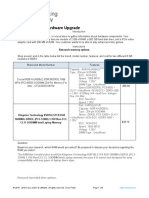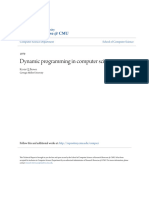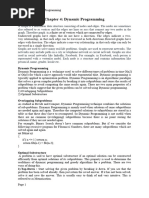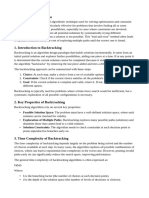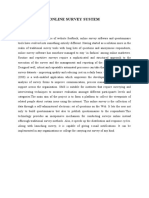Dynamic Programming
Uploaded by
pranshusahu862Dynamic Programming
Uploaded by
pranshusahu862Dynamic Programming (DP) Algorithms
Dynamic programming (DP) is a method used in computer science and mathematics to solve
problems by breaking them down into smaller subproblems and solving each subproblem just once,
storing the results for reuse. It is particularly useful for optimization problems where the solution to
a problem depends on solutions to smaller overlapping subproblems. DP helps reduce the time
complexity of algorithms that might otherwise have exponential time complexity.
1. Introduction to Dynamic Programming
Dynamic programming can be viewed as a technique to solve problems by solving each subproblem
once and storing the results to avoid recalculating them. The two main approaches in DP are:
• Top-Down Approach (Memoization): Solve the problem by recursively breaking it into
subproblems, while saving the results of subproblems (memoization) to avoid redundant
calculations.
• Bottom-Up Approach (Tabulation): Solve the problem iteratively by solving all possible
subproblems in a specific order and storing their solutions in a table.
2. Key Properties of Dynamic Programming Problems
For a problem to be solvable by DP, it should have two key properties:
• Overlapping Subproblems: The problem can be divided into smaller subproblems, and
these subproblems are solved multiple times.
• Optimal Substructure: The solution to the problem can be constructed efficiently from
solutions to its subproblems.
3. Types of Problems Solved Using DP
Dynamic programming is widely used for problems related to:
• Optimization: Maximizing or minimizing a particular quantity.
• Counting: Counting the number of ways something can occur.
• Sequence problems: Problems involving sequences, such as the longest common
subsequence or the longest increasing subsequence.
4. Basic Examples of Dynamic Programming Algorithms
4.1 Fibonacci Sequence
The Fibonacci sequence is one of the most basic examples of a problem solvable with DP. The
sequence is defined as: F(0)=0,F(1)=1,F(n)=F(n−1)+F(n−2)
• Naive Recursion: A simple recursive approach to calculating Fibonacci numbers can lead to
exponential time complexity.
• Memoization: By storing the results of each Fibonacci number, we avoid recalculating the
same value multiple times.
• Tabulation: An iterative approach that fills up a table of Fibonacci numbers from 0 to n.
Memoization Example:
python
Copy code
def fibonacci(n, memo={}):
if n <= 1:
return n
if n not in memo:
memo[n] = fibonacci(n-1, memo) + fibonacci(n-2, memo)
return memo[n]
Tabulation Example:
python
Copy code
def fibonacci(n):
dp = [0] * (n+1)
dp[1] = 1
for i in range(2, n+1):
dp[i] = dp[i-1] + dp[i-2]
return dp[n]
4.2 0/1 Knapsack Problem
The 0/1 Knapsack problem is a classic problem where we are given a set of items, each with a
weight and value, and we need to determine the maximum value we can achieve while staying
within a weight limit.
The problem can be solved using DP by constructing a table where each entry represents the
maximum value achievable for a given weight limit and subset of items.
Tabulation Example:
python
Copy code
def knapsack(weights, values, W):
n = len(weights)
dp = [[0] * (W+1) for _ in range(n+1)]
for i in range(1, n+1):
for w in range(1, W+1):
if weights[i-1] <= w:
dp[i][w] = max(dp[i-1][w], dp[i-1][w-weights[i-1]] + values[i-
1])
else:
dp[i][w] = dp[i-1][w]
return dp[n][W]
4.3 Longest Common Subsequence (LCS)
The LCS problem is a well-known problem where we are given two sequences, and we need to find
the longest subsequence that is common to both. This problem has a clear optimal substructure and
overlapping subproblems.
Tabulation Example:
python
Copy code
def lcs(X, Y):
m = len(X)
n = len(Y)
dp = [[0] * (n+1) for _ in range(m+1)]
for i in range(1, m+1):
for j in range(1, n+1):
if X[i-1] == Y[j-1]:
dp[i][j] = dp[i-1][j-1] + 1
else:
dp[i][j] = max(dp[i-1][j], dp[i][j-1])
return dp[m][n]
4.4 Longest Increasing Subsequence (LIS)
In the LIS problem, we are given an array of integers, and we need to find the length of the longest
subsequence such that all elements in the subsequence are sorted in strictly increasing order.
Tabulation Example:
python
Copy code
def lis(arr):
n = len(arr)
dp = [1] * n
for i in range(1, n):
for j in range(i):
if arr[i] > arr[j]:
dp[i] = max(dp[i], dp[j] + 1)
return max(dp)
5. Advanced Dynamic Programming Algorithms
5.1 Matrix Chain Multiplication
This problem involves finding the most efficient way to multiply a sequence of matrices. The
objective is to minimize the number of scalar multiplications.
Tabulation Example:
python
Copy code
def matrixChainMultiplication(p):
n = len(p) - 1
dp = [[0] * n for _ in range(n)]
for length in range(2, n+1):
for i in range(n - length + 1):
j = i + length - 1
dp[i][j] = float('inf')
for k in range(i, j):
q = dp[i][k] + dp[k+1][j] + p[i] * p[k+1] * p[j+1]
dp[i][j] = min(dp[i][j], q)
return dp[0][n-1]
5.2 Floyd-Warshall Algorithm
The Floyd-Warshall algorithm is used to find the shortest paths between all pairs of vertices in a
graph. It can handle graphs with negative edge weights (as long as there are no negative weight
cycles).
Tabulation Example:
python
Copy code
def floydWarshall(graph):
n = len(graph)
dist = [[float('inf')] * n for _ in range(n)]
for i in range(n):
dist[i][i] = 0
for u in range(n):
for v, weight in graph[u]:
dist[u][v] = weight
for k in range(n):
for i in range(n):
for j in range(n):
dist[i][j] = min(dist[i][j], dist[i][k] + dist[k][j])
return dist
6. Applications of Dynamic Programming
Dynamic programming is used in a variety of fields:
• Computational Biology: LCS and sequence alignment algorithms are used in DNA
sequence comparison.
• Economics: DP is used in solving problems like optimal pricing and resource allocation.
• Operations Research: Used in problems like optimal inventory management, shortest path,
and job scheduling.
• Artificial Intelligence: DP plays a key role in decision-making processes, such as in game
theory and reinforcement learning.
7. Conclusion
Dynamic programming is a powerful technique that allows solving complex problems by breaking
them into smaller, manageable subproblems. By storing the results of subproblems, DP significantly
reduces computation time, making it an essential tool in optimization, algorithm design, and
problem-solving.
For problems that involve optimization or counting and have overlapping subproblems and optimal
substructure, DP is often the key to an efficient solution.
You might also like
- Dynamic Programming in Computer ScienceNo ratings yetDynamic Programming in Computer Science49 pages
- LU-30 Dynamic Programming, Warshal, FloydNo ratings yetLU-30 Dynamic Programming, Warshal, Floyd16 pages
- Based On Stanford CS161 Slides From Summer 2021 by Karey ShiNo ratings yetBased On Stanford CS161 Slides From Summer 2021 by Karey Shi102 pages
- Design and Analysis of Algorithm Assignment # 01No ratings yetDesign and Analysis of Algorithm Assignment # 019 pages
- Introduction To Dynamic Programming: Ryan Jian November 8, 2013No ratings yetIntroduction To Dynamic Programming: Ryan Jian November 8, 20134 pages
- Dynamic Programming: by Dr.V.Venkateswara RaoNo ratings yetDynamic Programming: by Dr.V.Venkateswara Rao23 pages
- Dynamic Programming: Ananth Grama, Anshul Gupta, George Karypis, and Vipin KumarNo ratings yetDynamic Programming: Ananth Grama, Anshul Gupta, George Karypis, and Vipin Kumar42 pages
- AP_Dynamic Programming_ Algorithms and Complexity AnaNo ratings yetAP_Dynamic Programming_ Algorithms and Complexity Ana11 pages
- Analysis_and_Application_of_Dynamic_ProgrammingNo ratings yetAnalysis_and_Application_of_Dynamic_Programming5 pages
- Graphs - Shortest Paths 02 _ Class NotesNo ratings yetGraphs - Shortest Paths 02 _ Class Notes36 pages
- Dynamic Programming (DP) 02 - Class NotesNo ratings yetDynamic Programming (DP) 02 - Class Notes38 pages
- Inverse Trigonometric Functions (Trigonometry) Mathematics Question BankFrom EverandInverse Trigonometric Functions (Trigonometry) Mathematics Question BankNo ratings yet
- Mapping by Elementary Function and Conformal MappingNo ratings yetMapping by Elementary Function and Conformal Mapping8 pages
- GCSE Computer Science Specimen 3 Paper 01No ratings yetGCSE Computer Science Specimen 3 Paper 0116 pages
- C Language MCQ Part 2 (Multiple Choice Questions) - JavatpointNo ratings yetC Language MCQ Part 2 (Multiple Choice Questions) - Javatpoint26 pages
- Prof Duker - Online Mock - Ict (1) - Sit Up 2 - Marking SchemeNo ratings yetProf Duker - Online Mock - Ict (1) - Sit Up 2 - Marking Scheme5 pages
- 0262025442.MIT Press - Digital Library Use Social Practice in Deson Bishop, Nancy A. Van House, Barbara P. Buttenfield - Nov.2003No ratings yet0262025442.MIT Press - Digital Library Use Social Practice in Deson Bishop, Nancy A. Van House, Barbara P. Buttenfield - Nov.2003355 pages
- Campuslink - Admin - HCM21 - CPL - JAVA - 05 - Tests & QuizzesNo ratings yetCampuslink - Admin - HCM21 - CPL - JAVA - 05 - Tests & Quizzes8 pages
- Embedded Systems Dr. Santanu Chaudhury Department of Electrical Engineering Indian Institute of Technology, Delhi Lecture - 09 More On DSP ProcessorsNo ratings yetEmbedded Systems Dr. Santanu Chaudhury Department of Electrical Engineering Indian Institute of Technology, Delhi Lecture - 09 More On DSP Processors37 pages
- Dell EMC Unity Implementation and AdministrationNo ratings yetDell EMC Unity Implementation and Administration2 pages
- MODULE 2 - Process Flow Chart Description and ParametersNo ratings yetMODULE 2 - Process Flow Chart Description and Parameters2 pages
